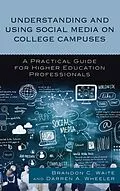The purpose of this book is to help higher education professionals approach social media initiatives strategically. It presents a framework for systematically thinking about the Internet Technology Environments (ITE) in which faculty, staff, and administrators operate. By foregoing a one-size-fits-all approach to social media use on campuses for one that is based upon structured inquiry, individuals can discern their unique campus environment and prepare for the challenges and opportunities they are likely to encounter. In addition to explaining why social media use on college campuses is glaringly inconsistent, the book highlights the approaches faculty and staff might take when designing and implementing social media initiatives, given the type of environment in which they work. It also introduces strategies these actors and administrators can utilize to strengthen their ITEs, ultimately facilitating the successful incorporation of social media technology into campus communications.
Autorentext
Brandon C. Waite, an Associate Professor of Political Science at Ball State University, earned his Ph.D. in political science from the University of Tennessee in 2008. His research deals with the use of online technologies for campaigning and organizational communication. Darren A. Wheeler, a Professor of Political Science at Ball State University, earned his Ph.D. in political science from Miami University in Oxford, Ohio in 2004. His teaching and research interests include judicial politics, the American presidency, terrorism and homeland security, and social media in administrative settings.
Inhalt
Dedication
Preface
Chapter 1: Introduction: Web 2.0 and Higher Education
History of Web 1.0
Web 2.0 Characteristics
Key Players in the Social Media Landscape
Social Media On College Campuses
Organizational Culture and Higher Education
The Internet Technology Environment
Chapter Outlines
Chapter 2: Social Media Initiatives: Institutional-Level Issues
Character and Identity
Resources
Compensation and Recognition
Policies
Conclusion
Chapter 3: Social Media Initiatives: Department-Level Issues
Academic Departments
Character and Identity
Resources
Compensation and Recognition
Policies
Conclusion
Chapter 4: Case Study: The Ball State University Political Science Facebook Page
Institutional-Level ITE
Departmental-Level ITE
Social Media and the Political Science at BSU
The Ball State University Political Science Department Facebook Page
Conclusion
Chapter 5: Putting It All Together
Behavior Strategies for Faculty and Staff: Social Media Ethos
Strategies for Administrators
Keys to Web 2.0 Success
Conclusion
Bibliography
Index
About the Authors
